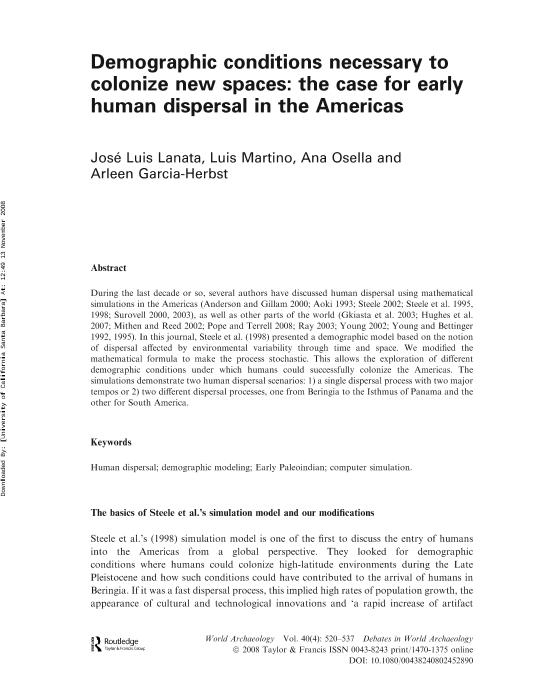Mostrar el registro sencillo del ítem
dc.contributor.author
Lanata, Jose Luis

dc.contributor.author
Martino, Luis Angel

dc.contributor.author
Osella, Ana
dc.contributor.author
Garcia Herbst, Arleen
dc.date.available
2019-09-10T16:22:28Z
dc.date.issued
2008-11-03
dc.identifier.citation
Lanata, Jose Luis; Martino, Luis Angel; Osella, Ana; Garcia Herbst, Arleen; Demographic conditions necessary to colonize new spaces: the case for early human dispersal in the Americas; Taylor & Francis; World Archaeology; 40; 4; 3-11-2008; 520-537
dc.identifier.issn
0043-8243
dc.identifier.uri
http://hdl.handle.net/11336/83252
dc.description.abstract
During the last decade or so, several authors have discussed human dispersal using mathematical simulations in the Americas (Anderson and Gillam 2000; Aoki 1993; Steele 2002; Steele et al. 1995, 1998; Surovell 2000, 2003), as well as other parts of the world (Gkiasta et al. 2003; Hughes et al. 2007; Mithen and Reed 2002; Pope and Terrell 2008; Ray 2003; Young 2002; Young and Bettinger 1992, 1995). In this journal, Steele et al. (1998) presented a demographic model based on the notion of dispersal affected by environmental variability through time and space. We modified the mathematical formula to make the process stochastic. This allows the exploration of different demographic conditions under which humans could successfully colonize the Americas. The simulations demonstrate two human dispersal scenarios: 1) a single dispersal process with two major tempos or 2) two different dispersal processes, one from Beringia to the Isthmus of Panama and the other for South America.
dc.format
application/pdf
dc.language.iso
eng
dc.publisher
Taylor & Francis

dc.rights
info:eu-repo/semantics/openAccess
dc.rights.uri
https://creativecommons.org/licenses/by-nc-sa/2.5/ar/
dc.subject
Computer Simulation
dc.subject
Demographic Modeling
dc.subject
Early Paleoindian
dc.subject
Human Dispersal
dc.subject.classification
Otras Historia y Arqueología

dc.subject.classification
Historia y Arqueología

dc.subject.classification
HUMANIDADES

dc.title
Demographic conditions necessary to colonize new spaces: the case for early human dispersal in the Americas
dc.type
info:eu-repo/semantics/article
dc.type
info:ar-repo/semantics/artículo
dc.type
info:eu-repo/semantics/publishedVersion
dc.date.updated
2019-08-27T18:32:49Z
dc.identifier.eissn
1470-1375
dc.journal.volume
40
dc.journal.number
4
dc.journal.pagination
520-537
dc.journal.pais
Reino Unido

dc.journal.ciudad
Londres
dc.description.fil
Fil: Lanata, Jose Luis. Consejo Nacional de Investigaciones Científicas y Técnicas. Centro Científico Tecnológico Conicet - Patagonia Norte. Instituto de Investigaciones en Diversidad Cultural y Procesos de Cambio. Universidad Nacional de Río Negro. Instituto de Investigaciones en Diversidad Cultural y Procesos de Cambio; Argentina. Fundación de Historia Natural Félix de Azara; Argentina. Universidad Maimónides. Área de Investigaciones Biomédicas y Biotecnológicas. Centro de Estudios Biomédicos, Biotecnológicos, Ambientales y de Diagnóstico; Argentina
dc.description.fil
Fil: Martino, Luis Angel. Consejo Nacional de Investigaciones Científicas y Técnicas; Argentina. Universidad de Buenos Aires. Facultad de Ciencias Exactas y Naturales. Departamento de Física. Grupo de Geofísica Aplicada; Argentina. Universidad Tecnológica Nacional; Argentina
dc.description.fil
Fil: Osella, Ana. Universidad de Buenos Aires. Facultad de Ciencias Exactas y Naturales. Departamento de Física. Grupo de Geofísica Aplicada; Argentina
dc.description.fil
Fil: Garcia Herbst, Arleen. University of California; Estados Unidos
dc.journal.title
World Archaeology
dc.relation.alternativeid
info:eu-repo/semantics/altIdentifier/url/https://www.tandfonline.com/doi/abs/10.1080/00438240802452890
dc.relation.alternativeid
info:eu-repo/semantics/altIdentifier/doi/http://dx.doi.org/10.1080/00438240802452890
Archivos asociados
